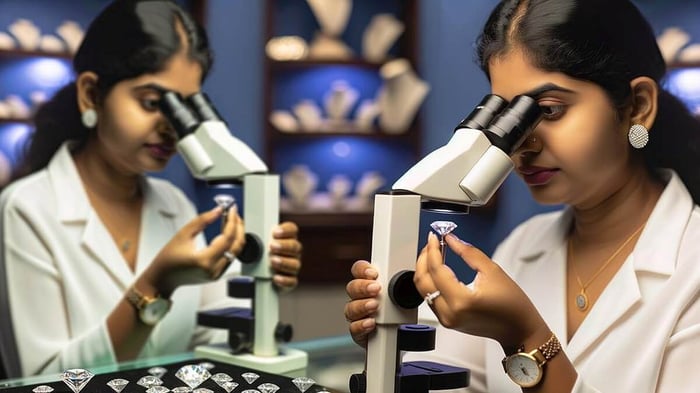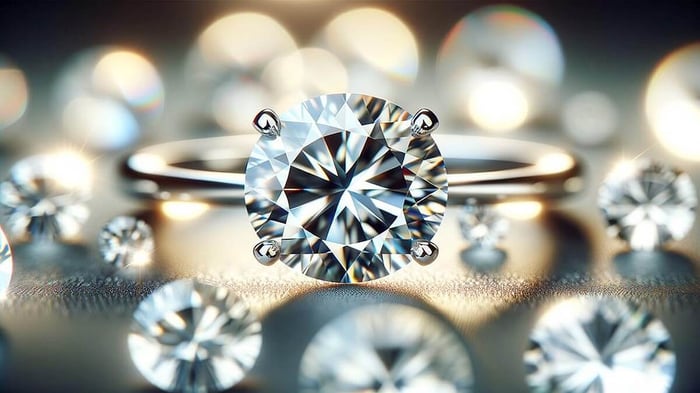In the captivating domain of diamonds, the ability to distinguish a true gem from a clever fake diamond is both an art and a science. Whether you're a seasoned collector, a hopeful romantic planning a proposal, or simply a curious enthusiast, the knowledge of how to verify a diamond's authenticity is invaluable.
With the market flooded with convincing fakes, understanding the subtle yet definitive tests to spot the real deal becomes essential. From the simple observation techniques to the more intricate scientific methods, each approach offers a unique insight into the heart of a diamond's true nature.
Let's set off on this enlightening journey together, and uncover the secrets that separate the genuine treasures from the artful deceits.
Collar con solitario de diamante de 1,00 ct G/SI en oro blanco de 18 k
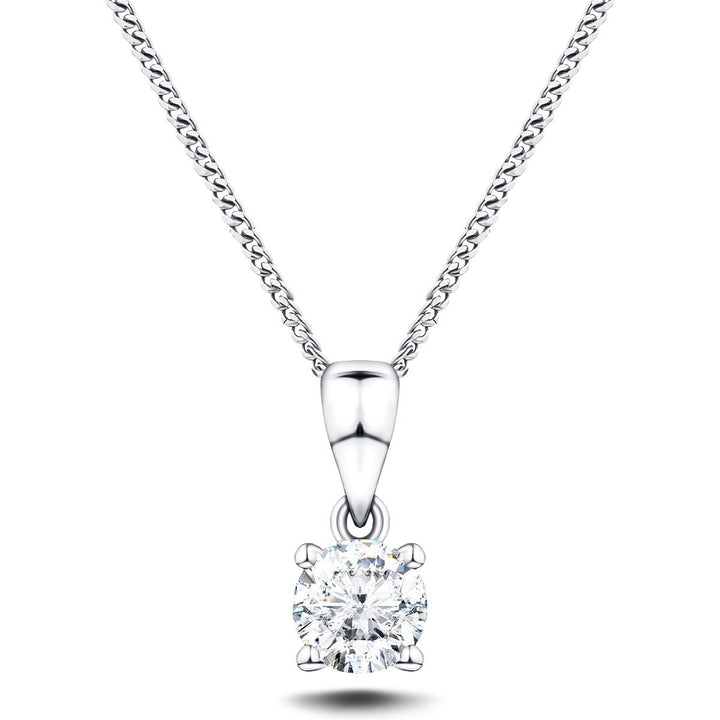
€7.278,95
Este hermoso y elegante collar con solitario de diamantes es un gran regalo para cualquier ocasión. Esta pieza versátil es perfecta para uso informal o formal y se puede usar con cualquier atuendo. Esta impresionante y moderna pieza está hecha… read more
Key Takeaways About Detecting Fake Diamonds
- The water test is a simple method to identify real diamonds by checking if they sink due to high density.
- Using a loupe for 10X magnification can reveal natural imperfections, aiding in distinguishing a fake diamond from the real thing.
- Real diamonds exhibit unique brilliance and fire, which can be analysed with professional tools like Brilliance Scopes.
- Expert consultation provides an accurate diamond authenticity assessment through specialized equipment and years of experience.
1) Water Test
Diving into the water test, it's fascinating to see how a real diamond, with its impressive density, will promptly sink, setting itself apart from the floaters that are the pretenders. This buoyancy comparison offers a clear, straightforward way to feel like you're part of a secret club that knows exactly how to spot the genuine article. After all, who doesn't want to wield the power to distinguish between the real deal and the impostors with just a glass of water?
For reference, this test is not foolproof but has a decent chance of picking out quartz or glass that's masquerading as diamond. it is possible that the fakes will not float, but if they sink they will either do so more slowly than a genuine diamond or sink only part-way through the water and remain suspended between the surface and the bottom of the container.
The density measurement involved in this process is nothing short of magical. By simply performing the flotation examination, you're engaging in an age-old technique that, despite its simplicity, remains incredibly effective. The immersion technique doesn't require any fancy equipment, just a keen eye and a curiosity to uncover the truth. When it comes to water displacement, it's all about observing how a real diamond, due to its higher density, doesn't just take a leisurely float but makes a beeline to the bottom, proving its authenticity beyond a shadow of a doubt. It's a beautifully simple yet profoundly telling experiment that brings us closer to the treasures of the earth.
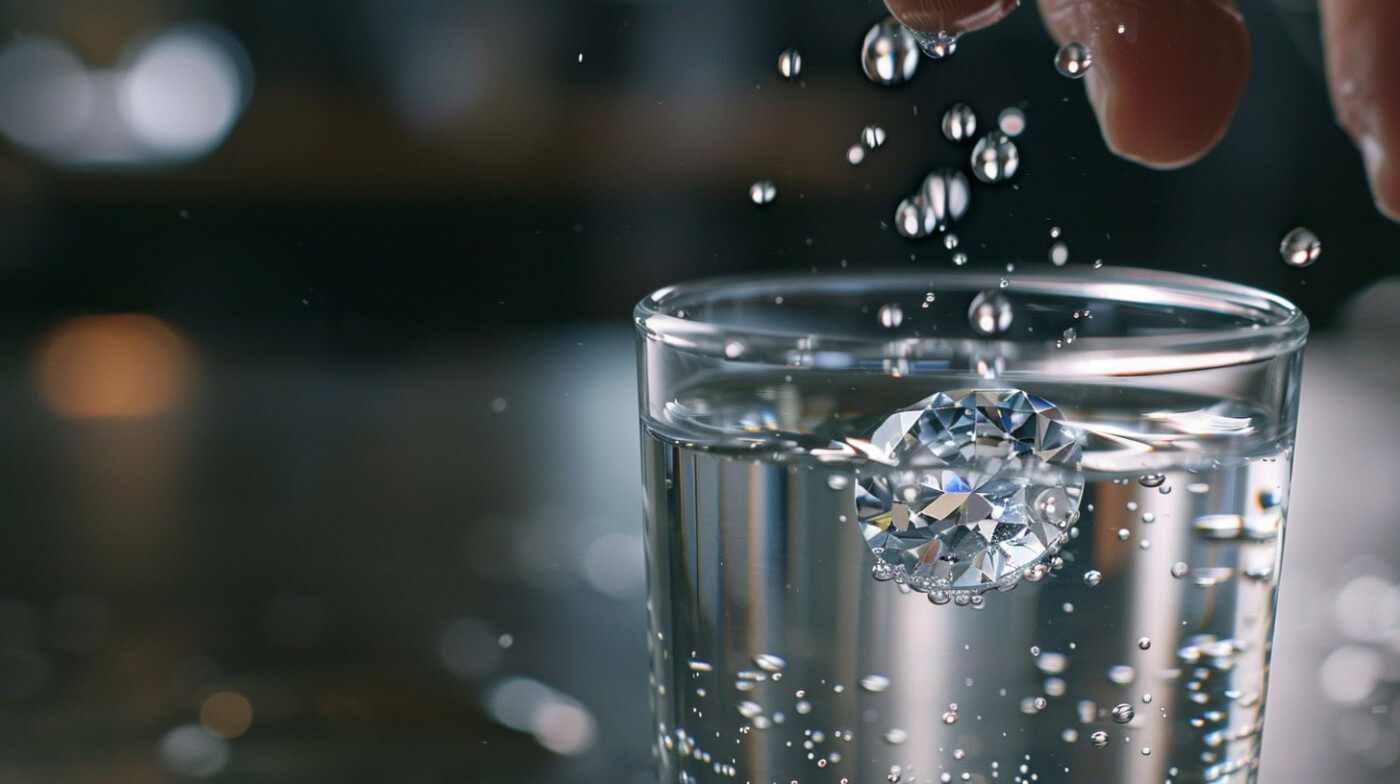
2) Fog Test
After exploring the straightforward water test, let's shift our focus to the fog test, a quick and revealing way to tell if a diamond is real or not. This nifty little trick is all about spotting the difference in thermal conductivity between a true diamond and an impostor, right from the comfort of your home. Who knew DIY testing could be this fun and insightful, right?
Here's how it goes:
1. Breathe on it - Just like you'd fog up a mirror, give your diamond a good huff. That simple breath is all you need to kick off your home verification process.
2. Watch for instant fog dispersal - A real diamond, thanks to its high thermal conductivity, won't hang onto that fog. It'll clear up quicker than you can say 'sparkle.'
3. Notice heat retention - If that fog lingers a bit too lovingly on your stone, it's a sign of lower thermal conductivity, hinting you might have a faker on your hands.
4. Repeat if needed - Not convinced? Give it another go. The beauty of this test is its simplicity and how it turns you into a diamond detective right at home.
VERY IMPORTANT: This test should be carried out in comparison with a known genuine diamond. That's because there is no fixed rate at which the fog on the surface of the gemstone will dissipate. The rate depends on the relative humidity and temperature of the surroundings. When you have a genuine diamond against which to make a comparison, the diamond should be faster than the fake.
Isn't it amazing how a little bit of breath can reveal so much about your precious gem?
3) Loupe Inspection
By closely examining a diamond's natural flaws, a loupe inspection—frequently overlooked by beginners—is a remarkably effective way to determine its authenticity. This technique, isn't just about peering through a magnifying glass; it's about joining a secret club of diamond detectives and uncovering the hidden truths that lie within these sparkling treasures.
With a 10X magnification loupe, you set off on a quest of facet evaluation, where sharpness and clarity speak volumes. It's like being a detective, searching for clues. Inclusion detection becomes your superpower, as you learn to appreciate the tiny blemishes and inclusions that make each real diamond unique—a proof of its journey from deep within the earth.
If the gem under examination looks perfect, or almost so, your suspicions should be aroused! A real diamond will have imperfections, a manufactured fake will almost certainly be flawless under magnification.
Clarity assessment through a loupe allows you to see beyond the surface, understanding that true beauty often lies in the imperfections. Authenticity verification becomes a personal triumph, as you differentiate the real from the fake with precision examination.
Brazalete con pavé de diamantes redondos Diamante G/SI de 1,50 quilates en oro blanco de 18 k
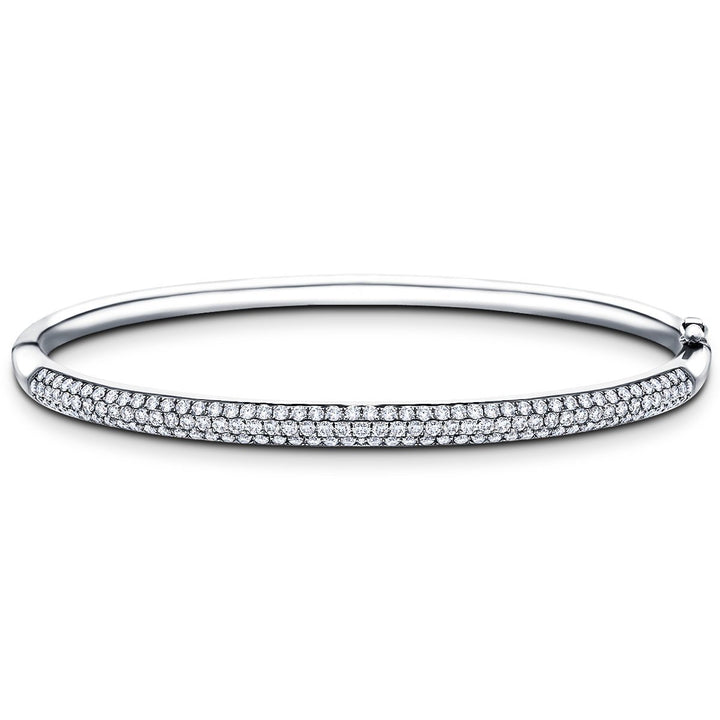
€3.585,95
Este hermoso brazalete está elaborado con un conjunto sofisticado de pavé de diamantes engarzados en oro blanco de 18k. Un diseño espectacular, esta pieza es ideal para aquellos que quieren añadir un toque moderno a su look diario. La clásica… read more
4) Weight Check
Stepping into the domain of gemmology, let's explore how the subtle nuances of weight can reveal the true nature of a diamond. It's like being part of a secret club, where understanding the mass of a diamond can make you feel like you're cracking mysteries.
When it comes to distinguishing between a real diamond and its imitators, the weight check is your go-to method. Here's how:
1. Density comparison: Real diamonds have a specific gravity of 3.52 grams per cubic centimeter. This unique characteristic sets them apart. Gather around, because comparing this to the denser cubic zirconia or the lighter moissanite is like revealing the first clue.
2. Balancing scales: Imagine placing your diamond on one side of the scale and a known mass on the other. It's a moment of tension and excitement as you wait to see if the balance tips.
3. Weight discrepancies: Spotting the differences in mass can feel like detective work. A cubic zirconia, about 55% heavier, is the imposter among us.
4. Measuring instruments: The precision of gemological scales is key here. Using these instruments for weight verification is like having the final say in a debate, a moment of truth that declares the authenticity of your diamond.
Understanding the weight of a diamond isn't just about numbers; it's about feeling connected to the beauty and rarity of these gems.
Of course, you're going to need very accurate scales—the type that a professional jeweller will have to hand. The digital scales in your kitchen are probably only accurate to +/- 2 grams which is nowhere near accurate enough.
Brazalete de diamantes en engarce de tensión Diamante G/SI de 0,75 quilates en oro rosado de 18 k
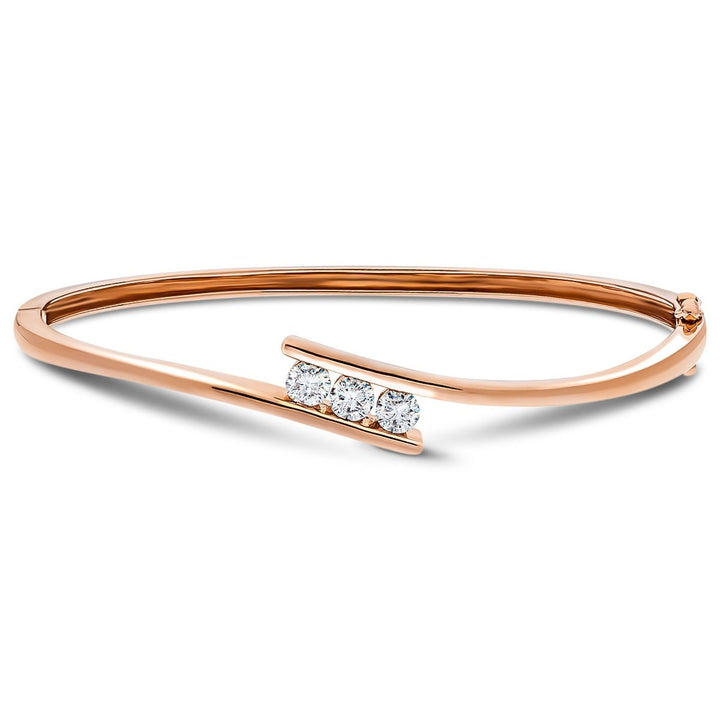
€3.781,95
Este hermoso brazalete es un verdadero clásico cuando se trata de joyas. Este brazalete de oro rosado de 18k, elaborado con un diseño clásico engastado en tensión, se verá genial en cualquier ocasión. Su color dorado es un hermoso complemento… read more
5) Heat Test
Looking closely into the heat test, it's fascinating how a real diamond, with its remarkable resilience, can easily shrug off the intense heat that might leave a fake diamond damaged or discoloured. This method is all about understanding the thermal properties that set a genuine diamond apart.
When you apply a flame directly to a diamond, observing its flame reaction becomes a significant indicator of authenticity. Real diamonds, thanks to their incredible heat resistance and high melting point, remain unscathed, showcasing their unmatched durability test performance.
On the flip side, materials like cubic zirconia or glass - often used in creating fake diamonds—don't stand a chance. They may crack, discolour, or even shatter when exposed to the same level of heat. It's this distinct difference in how they react to heat that can tell you a lot about what you're holding.
Brazalete de tenis con diamantes ilusión de 0,50 ct G/SI en oro blanco de 9 k
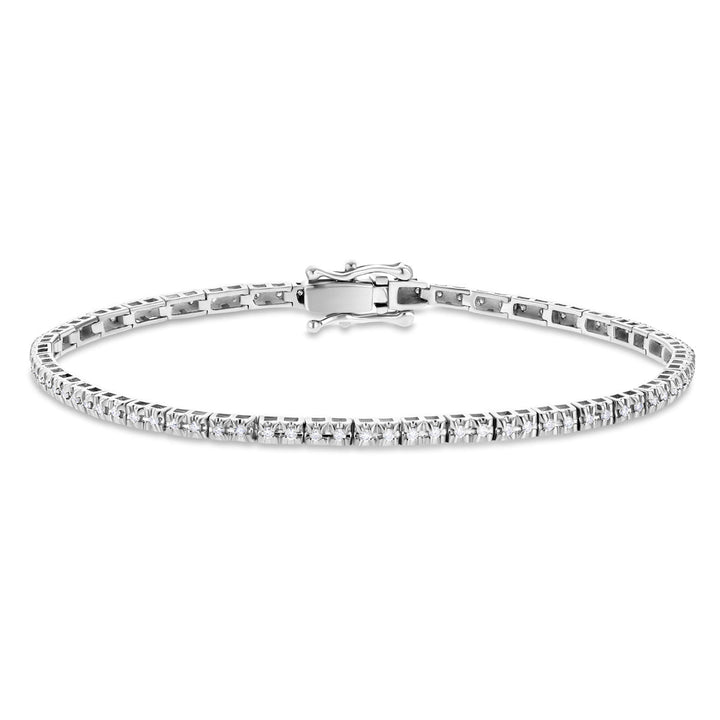
€978,95
Este brazalete de tenis, con un diseño glamuroso pero sencillo, presenta monturas de ilusión para los diamantes que realzan el atractivo visual de los diamantes. Con 0,50 quilates de diamantes de grado G/SI montados en oro blanco de 9Q, esta… read more
6) UV Light Examination
After exploring how a real diamond reacts to heat, let's now shine a light on how UV light examination can reveal the true nature of our sparkly friend. This technique is a bit like the secret handshake in the world of gemstone identification, where only the true gems know the correct response. When we discover a whole new dimension of understanding about our precious stones under UV light, we examine the mysterious glow, we uncover a whole new dimension of understanding about our precious stones.
Here's what to watch out for:
1. Fluorescence Patterns: Real diamonds often emit a blue fluorescence under UV light due to trace elements. It's like they're whispering, 'Yes, I'm the real deal.' A fake diamond will remain silent, without a trace of fluorescence.
2. UV Light Sources: Utilizing different UV light sources can provide varying insights, as the light emission can change subtly based on the light's intensity and wavelength.
3. Spectral Analysis: This isn't just a fancy term; it's a way to see how diamonds and their doppelgangers respond differently, revealing their true colours—or rather, the lack thereof.
4. Moissanite's Telltale Glow: Unlike our genuine sparkly friend, moissanite might betray itself with a slight green, yellow, or gray fluorescence, a clear giveaway under the discerning eye of UV light examination.
Pendientes Cluster de Diamantes 2.00ct Calidad G/SI en Oro Blanco 18k

€3.654,95
Si está buscando ofrecer un regalo de verdadero lujo ostentoso, entonces estos aretes de racimo de diamantes se ajustan perfectamente a sus necesidades. Con dos quilates completos de diamantes tallados a mano de origen ético engastados firmemente en oro blanco… read more
7) Sparkle Analysis
Let's explore the world of sparkle analysis, where the true beauty of a diamond reveals itself through its unique and mesmerizing light play. Come on this glittering journey with us, and feel the enchantment of diamonds as we break down how their sparkle can indicate their authenticity.
When it comes to diamonds, the sparkle isn't just about the shine; it's a thorough dance of light performance that involves colour grading, cut evaluation, clarity examination, and carat comparison. Genuine diamonds showcase unrivaled brilliance and fire, casting spectral colours and bright flashes, proof of their quality and craftsmanship. Unlike their counterfeit counterparts, which often present a dull or flat appearance, real diamonds captivate with their dynamic and vibrant light play.
Professionals often employ tools like Brilliance Scopes in sparkle analysis to precisely quantify the light performance of diamonds. This meticulous approach allows for a complete comparison, ensuring that each aspect of the diamond's sparkle, from its colour grading to its clarity examination, is thoroughly evaluated. In this way, sparkle analysis not only celebrates the inherent beauty of diamonds but also safeguards against the allure of imitations, ensuring you belong to the exclusive circle of genuine diamond lovers.
Anillo de compromiso y boda con diamantes redondos certificados 0,90 ct G/SI oro blanco de 18 k
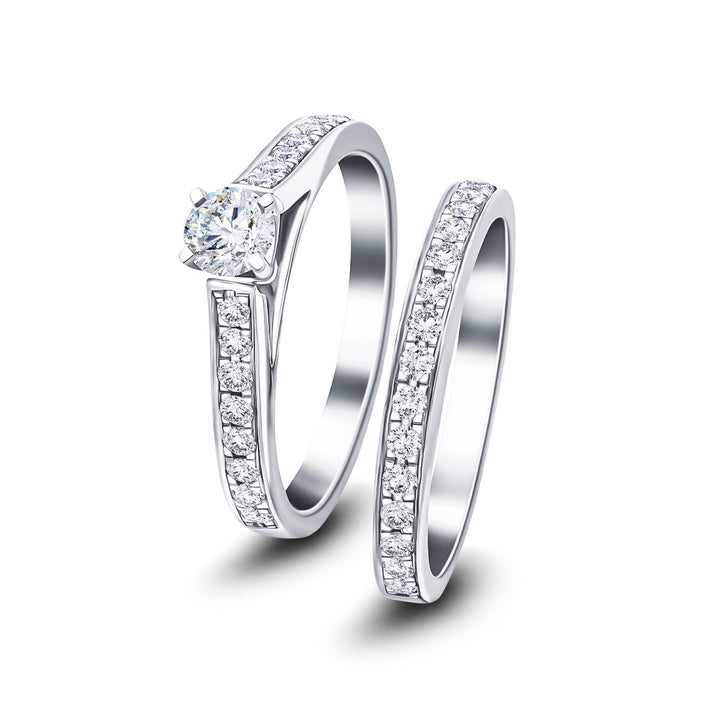
€1.923,95
Sabemos que quieres que todo en tu día especial sea perfecto. Asegúrese de que los anillos a juego sean algo menos de lo que preocuparse con este hermoso conjunto nupcial en oro blanco brillante de 18k con el brillo de… read more
8) Setting and Mount Verification
Moving on to the domain of setting and mount verification, it is essential to emphasize that the quality of the metal and the craftsmanship speak volumes about the authenticity of a diamond. It's like getting to know someone; the more you explore, the clearer their true nature becomes. In this spirit, let's investigate the nuts and bolts of this process:
1. Material Assessment: Peek at the metal housing your gem. Real diamonds often reside in high-class neighbourhoods like platinum or gold settings. It's a sign they're the real deal and not just pretending. If the setting is silver or some kind of base or plated metal, then a fake diamond may be living there. As always, this is not definitive! Silver settings are often used in budget diamond jewellery to save money, enabling the jeweller to use a better-quality or larger diamond.
2. Craftsmanship Evaluation: Check out how the diamond is nestled in its setting. A genuine diamond's setting is made with precision and care, showing off its bling securely and prominently.
3. Precision Inspection: The devil's in the details. Authentic pieces flaunt a flawless finish and meticulous construction. It's as if every angle and curve was crafted with love and respect for the stone's grandeur.
4. Security Verification: Real diamonds don't play hide and seek. Their settings are tight, making sure they won't move. High-quality prongs or bezels? That's a good sign you've got a keeper.
9) Expert Consultation
Turning to a diamond expert can be your best bet for separating the real gems from the impostors, offering a peek into the world of authentic sparkle. When you're standing at a crossroads, trying to figure out if your diamond is the real deal, nothing beats the reassurance and clarity that comes from expert advice. Imagine having someone who lives and breathes gemstones, offering you a diamond appraisal that clears all your doubts.
These wizards of the gem world use their years of experience and specialized equipment for a thorough authenticity assessment. Through gemstone analysis, they can unravel the mysteries of your diamond, ensuring that what you hold is a true treasure. It's not just about peace of mind; it's about being part of a community that treasures authenticity and quality above all.
Seeking a professional consultation is like opening a secret door to the hidden truths of your jewellery. With their guidance, you'll not only learn about the authenticity of your diamond but also gain insights into the fascinating world of gemology. So, when in doubt, remember that expert advice is your golden key to the world of real diamonds.
Frequently Asked Questions
What the Easiest Way to Tell if a Diamond Is Real or Fake?
Determining a diamond's authenticity can be straightforward with methods like the water and fog tests, which assess density and heat conductivity, respectively. Loupe examination for imperfections also provides valuable insights into a diamond's realness.
How Can You Tell if a Diamond Is Real With a Mirror?
To determine a diamond's authenticity using a mirror, observe the mirror reflection test. Genuine diamonds display unique reflective quality, lack surface scratches, show no fogging effect, and their mirror symmetry highlights their real, unmatched brilliance.
How Can You Tell if a Diamond Is Real by Eye?
To verify a diamond's authenticity by eye, perform the Sparkle Test to assess its brilliance, observe Refractivity for unique light patterns, seek Expert Appraisal, test under UV Light, and conduct a Hardness Check.
Can You Test a Diamond With Your Phone?
It is not reliable to test a diamond's authenticity using your phone. Methods like diamond apps, phone magnification, light refraction, digital weighing, or the screen scratch test lack the precision of professional tools and expertise.
Anillo de compromiso de diamantes con montura de hombro certificada de 1,35 ct G/SI en platino
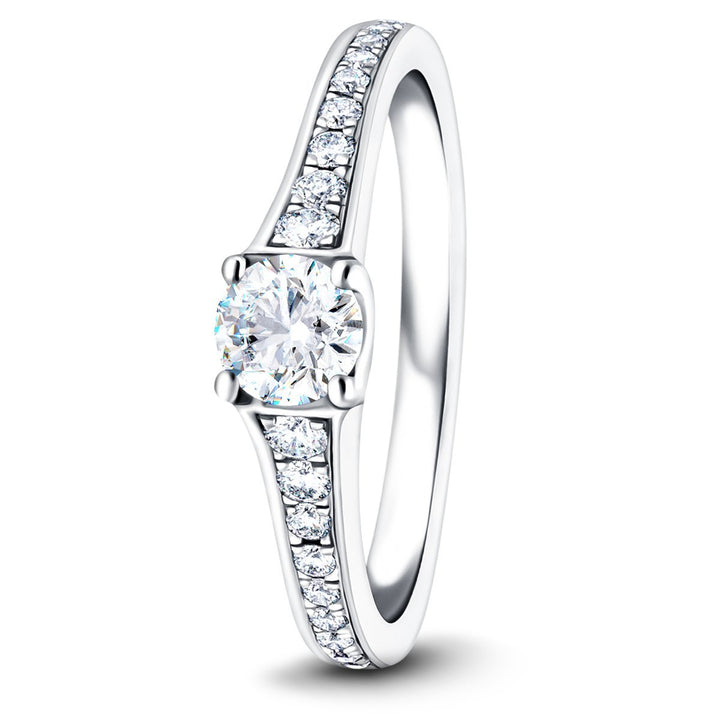
€7.797,95
Demuéstrele cuánto la ama con este hermoso y único anillo de compromiso creado especialmente para ella. La impresionante combinación de acentos de diamantes y delicados diseños de filigrana la harán sentir como si estuviera caminando en el aire. Diseñado en… read more
Now, You Won't get Stuck With Fake Diamond Jewellery!
To sum up, distinguishing between real diamonds and fake diamonds requires a keen understanding of their distinct characteristics. By applying methods such as the water test, fog test, and loupe inspection, individuals can gain valuable insights into the authenticity of these precious stones. You might be interested in our article about how synthetic and fake diamonds are created.
Techniques like heat and UV light examinations, along with sparkle analysis and setting checks, further aid in this discernment. Ultimately, when in doubt, seeking expert consultation remains invaluable.
While some of the tests you can do for yourself: are fog, loupe, heat, and water tests, some, the most revealing are 'professional only'. In truth, we would suggest letting a professional gemologist or jeweller deal with setting suspected gemstones alight too! If you carry out any of these tests, it is a good idea to use several rather than just one because most of these tests are indicative and not conclusive.
One safeguard that you can rely on is a diamond certification provided by a reputable diamond grading lab such as IGI or GIA. These reports describe the diamond in great detail and can be reliably tied to each diamond by a simple checking process that a jeweller can do for you.
Here at All Diamond, many of our pieces of jewellery are supplied with a diamond grading certificate. You can also rely on the value of our reputation and the standards we set. See our Trustpilot reviews!
Every piece of jewellery we sell has a lifetime workmanship guarantee and carries UK hallmarks to guarantee the quality of the precious metals our craftsmen use.
We would be proud to supply your next piece of diamond jewellery, all real, all-natural - of course!
Please take a few minutes to browse our collections of fine diamond jewellery. Perhaps you will be inspired by the work of the fine British design and craftsmanship that you will find on our pages!
